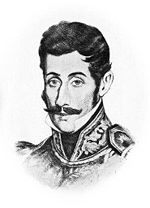Partido Nacional (Uruguay)
| Partido Nacional | |
|---|---|

|
|
| Party leader | Beatrice Argimón |
| founding | 1836 |
| Headquarters | Montevideo |
| Alignment |
Conservatism currents: nationalism Christian democracy centrism economic liberalism social liberalism |
| Colours) | _ |
| Seats in the House of Representatives |
32/99 |
| Seat in the Senate |
10/30 |
| Website | partidonacional.com.uy |
The Partido Nacional (formerly Partido Blanco , German National Party , White Party ) is a party in Uruguay .
The party is considered to be more conservative , rural and ecclesiastical. Within the overall party, known as the Lema , there are different programmatic positions that manifest themselves in the formation of various Sublema and individual groupings, the so-called clubs or lists. A significant current within the Partido Nacional is the so-called herrerist wing. Other significant sublemas are or were, for example, the Unión Blanca Democrática , which unified the majority of votes within the party in the elections in 1958 (25.2%) and 1962 (20.2%) , which in 1954 was the second strongest force within the party (12.1%). ) forming Movimiento Popular Nacionalista , Herrerismo-Ruralismo (1966 strongest sublema with 19.2%) or Por la Patria / Movimiento Nacional Rocha (so-called Ferreira faction, which in 1971 was the strongest sublema with 30.3% of the votes).
history
The Partido Nacional was founded in 1836. The first decades of the party were marked by fighting against the Partido Colorado ( German Red Party ). In 1839 a civil war broke out between the Conservatives (Blancos) under Manuel Oribe and the Liberals (Colorados) under José Fructuoso Rivera . The war lasted until 1851 and ended with a victory for the Colorado. The last Blanco government fell victim to the imperialism of the Colorados and their foreign allies ( Brazil , France ) in 1865 . It was not until 1958 that the nationalists came back to power. Between 1872 and 1904 there were several Los Blancos uprisings against the liberal Colorado government, which relied on the liberal and social democratic camp in Montevideo and the southern coastline. Aparicio Saravia led the last revolution in 1904 after the Colorados ignored authoritarian agreements with the National Party.
In the course of the beginning of Gabriel Terra's dictatorship, there was a factional split in the Los Blancos with the constitution of 1934. While the distribution of power at that time was controlled across party lines by the majority of the conservative faction, together with the anti-bat wing of the Partido Colorado, the faction of the Partido Nacional Independiente boycotted the political process. In the following years, this ran independently. A reintegration into the political process followed in the course of the so-called golpe bueno (good coup) Alfredo Baldomir through this. After the dissolution of parliament, Baldomir agreed on a constitutional reform both with the opposition parts of the Blancos, the Partido Nacional Independiente, as well as with the Colorado Batllista faction, which was also excluded from the political process at the time . The formal split in terms of the Partido Nacional was finally overcome in 1954. The subsequent return of the Partido Nacional Independiente to the Lema of the party as a whole and the inclusion of the Liga Federal de Acción Ruralista , an originally anti-partisan and anti-modernist movement, by way of an alliance subsequently led to the breakthrough of almost a hundred years Dominance of the Colorado. The 1958 and 1962 elections subsequently decided the Blancos in their favor with 51.5% and 47.5% respectively.
When the domestic political situation was marked by social tensions and dissatisfaction of the population with the conservative government, the Marxist movement of the " Tupamaros " (after the last Inca king Túpac Amarú), who carried out terrorist attacks as so-called "urban guerrillas", formed. During this time under the re-ruling Colorados (from 1967) Wilson Fereira Aldunate led the Blancos. He was considered the Attorney General of Uruguay, as he indicted the authoritarian Colorados and the Tupamaros at the same time.
In 1990 Luis Alberto Lacalle of the Partido Nacional became the new head of state (until 1995), but essentially continued the policy of his predecessor. A currency reform in 1993 introduced the peso as the new currency in the country.
Symbols
Web links
Individual evidence
- ^ Presidentialism and Democracy in Latin America : Uruguay (1942-1973), p. 163ff , by Bernhard Thibaut


